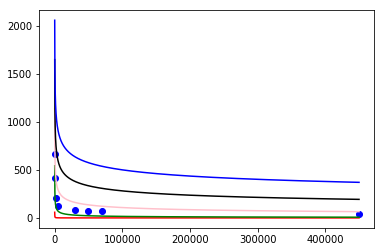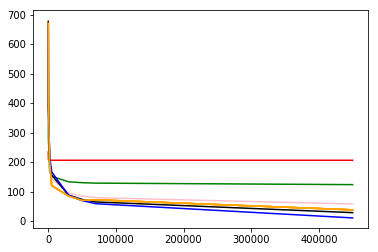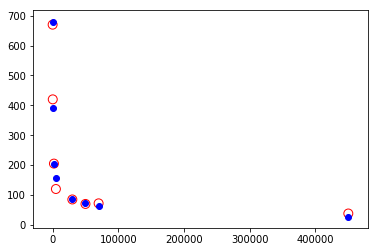动物心率与体重的模型
动物消耗的能量p主要用于维持体温,而体内热量通过其表面积S散失,记动物体重为w,则(P propto S propto w^{alpha})。又(P)正比于血流量(Q),而(Q=wr),其中(q)是动物每次心跳泵出的血流量,(r)为心率。假设(q)与(r)成正比,于是(P propto wr)。于是有(r propto w^{alpha-1}=w^a),有(r=kw^a+b)。
import numpy as np
import matplotlib.pyplot as plt
import torch
import math
%matplotlib inline
r=np.array([[670],[420],[205],[120],[85],[70],[72],[38]])
w=np.array([[25],[200],[2000],[5000],[30000],[50000],[70000],[450000]])
plt.plot(w,r,'bo')
x_sample = np.arange(85, 450000, 0.1)
bottom_range = [1,2,3,4,5]
color = ['red','green','pink','black','blue']
for i in range(5):
y_sample = 5000*x_sample**(-1/bottom_range[i])
plt.plot(x_sample, y_sample, color[i],label='real curve')

由上图的预模拟,考虑(r)的指数为(-1),(-frac{1}{2}),(-frac{1}{3}),(-frac{1}{4}),(-frac{1}{5}),从中选取误差最小的
from torch.autograd import Variable
from torch import nn
from torch import optim
import math
#生成目标函数 构建数据集
x_train = w
x_train = torch.from_numpy(x_train).float()
x_train = Variable(x_train)
y_train = torch.from_numpy(r).float()
y_train = Variable(y_train)
#构建模型
class poly_model(nn.Module):
def __init__(self,bottom):
super(poly_model,self).__init__()
self.k = nn.Parameter(torch.randn(1))
self.b = nn.Parameter(torch.zeros(1))
self.bottom = bottom
def forward(self,x):
out = (x)**(-1/self.bottom)*self.k+self.b
return out
for i in range(5):
print("exponential is -1/%d"%(bottom_range[i]))
model = poly_model(bottom_range[i])
criterion = nn.MSELoss()
optimizer = optim.SGD(model.parameters(),lr=1e-3)
# 更新参数
for j in range(150000):
output = model(x_train)
loss = criterion(output,y_train)
optimizer.zero_grad()
loss.backward()
optimizer.step()
if(j%50000 == 0):
print(loss.item())
if(loss.item() < 1e-3): break
print(model.parameters())
y_pred = model(x_train)
plt.plot(x_train.data.numpy()[:, 0], y_pred.data.numpy(), label='fitting curve', color=color[i])
plt.plot(w, r, label='real curve', color='orange')
经过150000轮预训练,我们得到如下图,表中为曲线颜色对应的指数
| 指数 | 颜色 | 误差 |
|---|---|---|
| -1/1 | 红 | 41184 |
| -1/2 | 绿 | 10599 |
| -1/3 | 粉 | 1195 |
| -1/4 | 黑 | 360 |
| -1/5 | 蓝 | 468 |
其中误差最小的项为(-frac{1}{4})

这里可以做一些交叉熵验证找一个最佳的learning rate代码就不贴了 随机生成学习率即可,经过100次验证 我得到的最佳学习率是0.20485,收敛的很快
model = poly_model(4)
criterion = nn.MSELoss()
optimizer = optim.SGD(model.parameters(),lr=0.20485)
for j in range(50001):
output = model(x_train)
loss = criterion(output,y_train)
optimizer.zero_grad()
loss.backward()
optimizer.step()
if(j%50000 == 0):
print(loss.item())
y_pred = model(x_train)
plt.plot(x_train.data.numpy()[:, 0], y_pred.data.numpy(), label='fitting curve', color=color[i])
plt.plot(w, r, label='real curve', color='orange')

打印模型参数
param = list(model.parameters())
print(param)
[Parameter containing:
tensor([1591.8446], requires_grad=True), Parameter containing:
tensor([-33.6434], requires_grad=True)]
通过交叉验证,使用0.20485的学习率学习50000轮后,最终模型为(r=1591.84w^{-frac{1}{4}}-33.64),均方误差为304.288
| 动物 | 实际心率 | 预测心率 | 偏差 |
|---|---|---|---|
| 田鼠 | 670 | 680 | +10 |
| 家鼠 | 420 | 390 | -30 |
| 兔 | 205 | 204 | -1 |
| 小狗 | 120 | 155 | +35 |
| 大狗 | 85 | 87 | +2 |
| 羊 | 70 | 72 | +2 |
| 人 | 72 | 63 | -9 |
| 马 | 38 | 27 | -11 |
